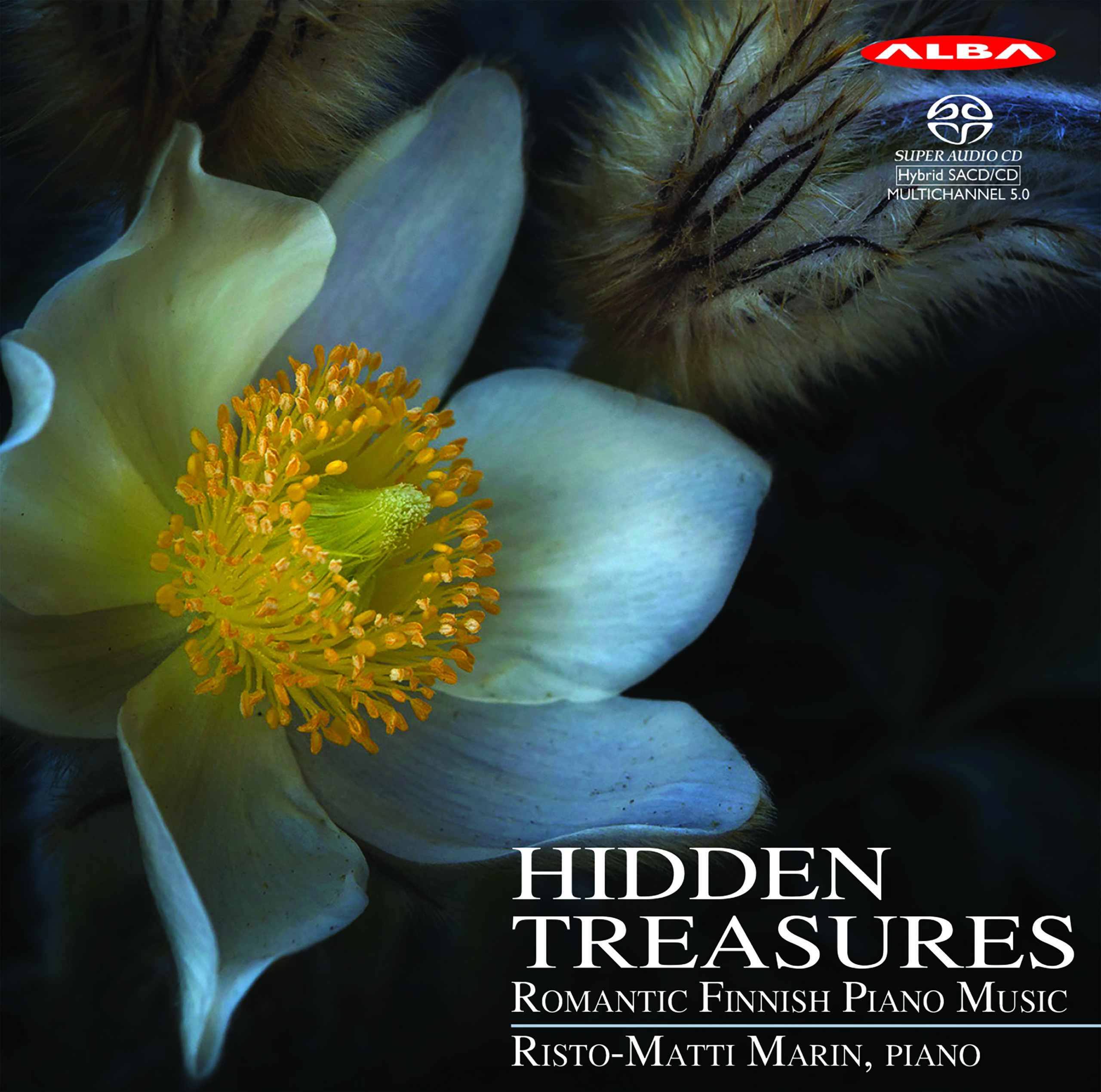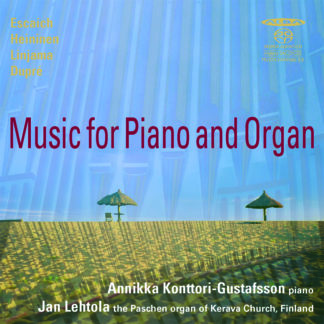Reviews

Risto-Matti Marin: Hidden Treasures. Alba. ★★★★★
RISTO-MATTI MARIN hämmästyttää soittonsa suvereeniudella. Levyllä esille nostetut suomalaiset romanttistyyliset pianoteokset vajaan sadan vuoden ajalta tarjoavat herkullisia näytön paikkoha. Ilmari Hannikaisen ja Einari Marvian pianosonaatit sekä Martin Wegeliuksen Kolme fantasiakappaletta soivat täyteläisen uhkeina, hennon lyyrisinä ja haaveellisen salaperäisinä. Richard Faltinin Muunnelmia omasta teemasta huipentuu huumaavaan jylinään.
Sirkka Harjunmaan Häämarssi ja Etydi ovat levyn napakka poikkeus ennen Marvian raikkaasti tyylitteleviä Muunnelmia eteläpohjalaisesta kansanlaulusta.
Klassinen, albumi
Hiddden Treasures – Romantic Finnish Piano Music; Richard Faltin: Variations on an Original Theme; Ilmari Hannikainen: Klaviersonate op. 1; Martin Wegelius: Memories of a Day in Saxon Switzerland; Sirkka Harjunmaa: Wedding March + Etude; Einari Marvia: Klaviersonate op. 16 + Variations on an Ostrobothnian Folk Song; Risto-Matti Marin, Klavier; 1 CD Alba Records ABCD 446; Aufnahme 2018, Veröffentlichung 09/2019 (82’14)
Interessant in diesem Programm ist gewiss die sehr einfallsreiche und entsprechend originelle Sonate von Ilmari Hannikainer (1892-1955) mit einem tief empfundenen Andante cantabile, einem wunderbar burlesken Scherzo und einem reich dekorierten Finalsatz. Ein absolut hörenswertes und vergnügliches Werk!
Das erste der drei Fantasiestücke ‘Erinnerungen an einen Tag in der Sächsischen Schweiz’ beginnt träumerisch-ruhig, mutiert dann ins hoch Virtuose, fällt aber bald wieder ins Verträumte und endet auch so. Auch die zweite Fantasie, Andante quasi Allegretto, ist eher verhalten und die dritte, Poco adagio, ma rubato, ist grüblerisch und es manifestiert sich darin auch Unmut. Versuche zum Ausbruch aus diesen Stimmungen sind ansatzweise zu spüren, gelingen aber nicht. Was war da los in der Sächsischen Schweiz?
Die übrigen Stücke des Programms sind, obschon nicht uninteressant, nicht vom selben Kaliber.
The most interesting work in this program is certainly the very imaginative and accordingly original sonata by Ilmari Hannikainer (1892-1955) with a deeply felt Andante cantabile, a wonderfully burlesque Scherzo and a richly decorated final movement. An absolutely enjoyable work!
The first of the three fantasy pieces ‘Erinnerungen an einen Tag in der Sächsischen Schweiz’ (Memories of a Day in Saxon Switzerland) begins dreamily, then changes into high virtuosity, but soon falls back into a more dreamy mood and also ends like this. The second fantasy, Andante quasi Allegretto, is rather restrained, and the third, Poco adagio, ma rubato, has a brooding tone manifesting even displeasure. Attempts to break out of these moods can be felt to some extent, but they don’t succeed. What was going on in Saxon Switzerland?
The other pieces in the programme, although not uninteresting, are not of the same calibre.
Musicweb international
An interesting selection of little known Finnish music; the Hannikainen is the standout.
Hidden Treasures – Romantic Finnish Piano Music
Richard FALTIN (1835-1918)
Variations on an Original Theme (1861) [9:05]
Ilmari HANNIKAINEN (1892-1955)
Piano Sonata in C Minor Op.1 (1912) [28:02]
Martin WEGELIUS (1846-1906)
Memories of a Day in Saxon Switzerland (1872) [15:19]
Sirka HARJUNMAA (1926-2018)
Wedding March (1948) [2:35]
Etude (1947) [1:32]
Einari MARVA (1915-1997)
Piano Sonata in D Flat Major OP.16 (1945) [16:58]
Variations on an Ostrobothnian Folk Song Op.19 [8:07]
Risto-Matti Marin (piano)
rec. Kangasala, Finland, 2018
ALBA SACD ABCD446 [82:14]
This is an SACD recording that I have listened to via a 2-Channel SACD system and a 2 channel CD system. The recording is excellent in both cases.
Here Alba Records and the excellent pianist Risto-Matti Marin, have presented us with a selection of piano works from the pens of five Finnish composers, whose names are not exactly household ones, at least not outside Finland or the Nordic countries. With the exception of Martin Wegelius, whose name rings a faint bell (it turns out that he was Sibelius’ teacher), I had never heard of any of these composers. As far as I am concerned though, that is in no sense off-putting – I love exploring the byways of romantic music. It is clear from the informative booklet notes, that the works of Faltin, Hannikainen, Wegelius, Hartunmaa and the Ostrobothnian Variations by Marvia are compositions from the beginnings of their respective careers – the early to mid-twenties.
Only the sonata by Marvia is a mature work, and even then, she was only 30 when it was composed. It is hardly surprising therefore that none of them demonstrate any great individuality. The longest work is the 28-minute Sonata in C minor by Ilmari Hannikainen, who was himself a pianist of international stature – he gave the UK premiere of the revised version of Rachmaninov’s 1st Piano Concerto in 1921.
The booklet states that the first movement reveals traces of Liszt and Chopin, the latter’s style being especially noticeable in the first subject. I myself was struck by traces of Rachmaninov in the very opening of the movement, and particularly in the arching climax of the lovely second movement, where the gradual build-up to the peak is particularly impressive. The scherzo movement (A-B-A format), has a memorable ‘B’ section – a rustic dance derived from the first subject of the first movement. It is noticeable that in the melodically abundant last movement, a bell-like section recalls the chant of the Russian Orthodox Church – it is worth recalling that at this time, Finland was a Grand Duchy of the Russian Empire. The other sonata is the Op.16 of Einari Marvia, composed in 1945. The themes are rather simplistic, with the composer concentrating on surging harmonies. The second movement carries on from the last note of the first, yielding a rather dissonant introductory section. In contrast, the middle and end is tranquil. The booklet describes the last movement as being a “musical jungle”, being highly eventful and ending in a Rachmaninovian blaze. It is quite an attractive piece, but doesn’t show any truly individual characteristics.
Martin Wegelius composed his Three Fantasy Pieces in 1872. It represents memories of three days in Switzerland. It seems that he borrowed its title from Schumann, one of his favourite composers. Influences from Schubert and Mendelssohn are also apparent, and to be frank, it seems to me that the piece could have been composed by almost any technically competent student of German music. Distinctive and memorable, it is not.
The CD opens with Richard Faltin’s Variations on an Original Theme, composed when he was 26. Like so many music students, he was subject to a German musical education in Leipzig, but despite a varied career, he is remembered mainly as an organist, having composed many hymn tunes. The booklet states that this work is classified as juvenilia, and that he based it on Mendelssohn’s Variations sérieuses – not a work that I am at all familiar with. Whilst I may agree with the writer of the notes, that it demonstrates compositional skill and ferocious difficulty, I’m afraid that for me, that is about as far as it goes.
Einari Marvia was 20 when he composed his Variations on an Ostrobothnian Folk Song. I find that it appeals to me rather more than his sonata of 10 years later, despite the booklet notes’ claim that the sonata shows a marked development in his technique. I notice various composers’ styles in the variations – Chopin, Schumann and Rachmaninov. It is quite an entertaining piece, and probably because the folk song itself has a short but quite catchy tune, is easy to enjoy, even when only listening with half an ear.
Sirkaa Harjunmaa is represented by two very short pieces – her Wedding March of 1948 and an Etude of 1947. The march was written under the inspiration of falling in love, but the composer has said that there is nothing feminine about it, indeed she told the pianist on this recording that when performing it, he should “think about Sibelius”. All I can say to that is that it sounds like a military march and bears no resemblance to any Sibelius that I know, though I confess ignorance of his piano music. The slightly earlier etude has some slight jazzy syncopations, but passes in a flurry of notes.
The overall impression given to me by the CD is that I should like to hear more of Hannikainen’s music, preferably his more mature works. The remaining pieces are pleasant, but hardly point to what might come along later as the composers matured.
The booklet is comprehensively detailed about the lives of the composers, and each work is given a brief but adequate description.
Jim Westhead
musicweb-international.com







